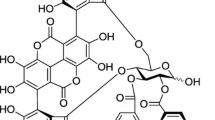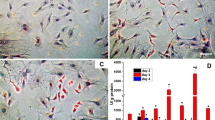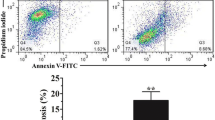Abstract
Objectives: Apelin is a recently discovered peptide that is the endogenous ligand for the orphan G-protein-coupled receptor APJ. Adipocytes can express and secrete apelin. Osteoblast can express apelin and APJ. The aim of this study was to investigate the action of apelin on apoptosis of human osteoblasts. Results: Apelin inhibited human osteoblasts apoptosis induced by serum deprivation. Suppression of APJ with small-interfering RNA (siRNA) abolished the anti-apoptotic activity of apelin. Our study also showed an increased Bcl-2 protein expression and decreased Bax protein expression under the treatment of apelin. Apelin decreased cytochrome c release and caspase-3 activation in human osteoblasts. Apelin activated phosphatidylinositol-3 kinase (PI-3 kinase) and Akt. The apelin-induced activation of Akt was blocked by suppression of APJ with siRNA. LY294002 (a PI-3 kinase inhibitor) or 1L-6-hydroxymethyl-chiro-inositol 2-(R)-2-O-methyl-3-O-octadecylcarbonate (HIMO; an Akt inhibitor) abolished apelin induced activation of Akt, and, LY294002 or HIMO abolished the anti-apoptotic activity of apelin. Furthermore, apelin protects against apoptosis induced by the glucocorticoid dexamethasone. Conclusions: Apelin suppresses serum deprivation-induced apoptosis of human osteoblasts and the anti-apoptotic action is mediated via the APJ/PI-3 kinase/Akt signaling pathway.
Similar content being viewed by others
References
Stewart KJ, Deregis RJ, Turner KL et al (2002) Fitness, fatness and activity as predictors of bone mineral density in older persons. J Intern Med 252:381–88
Lim S, Joung H, Shin CS et al (2004) Body composition changes with age have gender-specific impacts on bone mineral density. Bone 35:792–98
Lindsay R, Cosman F, Herrington BS, Himmelstein S (1992) Bone mass and body composition in normal women. J Bone Miner Res 7:55–2
Felson DT, Zhang Y, Hannan MT, Anderson JJ (1993) Effects of weight, and body mass index on bone mineral density in men and women. J Bone Miner Res 8:567–73
Glauber HS, Vollmer WM, Nevitt MC, Ensrud KE, Orwoll ES (1995) Body weight versus body fat distribution, adiposity, and frame size as predictors of bone density. J Clin Endocrinol Metab 80:1118–123
Khosla S, Atkinson EJ, Riggs BL, Melton LJ (1996) Relationship between body composition and bone mass in women. J Bone Miner Res 11:857–63
Xie H, Tang SY, Cui RR et al (2006) Apelin and its receptor are expressed in human osteoblasts. Regul Pept 134:118–25
De Mota N, Reaux-Le Goazigo A, El Messari S et al (2004) Apelin, a potent diuretic neuropeptide counteracting vasopressin actions through inhibition of vasopressin neuron activity and vasopressin release. Proc Natl Acad Sci USA 101:10464–0469
Kleinz MJ, Davenport AP (2004) Immunocytochemical localization of the endogenous vasoactive peptide apelin to human vascular and endocardial endothelial cells. Regul Pept 118:119–25
Kawamata Y, Habata Y, Fukusumi S et al (2001) Molecular properties of apelin: tissue distribution and receptor binding. Biochim Biophys Acta 1538:162–71
Habata Y, Fujii R, Hosoya M et al (1999) Apelin, the natural ligand of the orphan receptor APJ, is abundantly secreted in the colostrum. Biochim Biophys Acta 1452:25–5
Tatemoto K, Hosoya M, Habata Y et al (1998) Isolation and characterization of a novel endogenous peptide ligand for the human APJ receptor. Biochem Biophys Res Commun 251:471–76
Wei L, Hou X, Tatemoto K (2005) Regulation of apelin mRNA expression by insulin and glucocorticoids in mouse 3T3-L1 adipocytes. Regul Pept 132:27–2
Boucher J, Masri B, Daviaud D et al (2005) Apelin, a newly identified adipokine up-regulated by insulin and obesity. Endocrinology 146:1764–771
Lee DK, Cheng R, Nguyen T (2000) Characterization of apelin, the ligand for the APJ receptor. J Neurochem 74:34–1
O’Dowd BF, Heiber M, Chan A et al (1993) A human gene that shows identity with the gene encoding the angiotensin receptor is located on chromosome 11. Gene 136:355–60
Hosoya M, Kawamata Y, Fukusumi S (2000) Molecular and functional characteristics of APJ: tissue distribution of mRNA and interaction with the endogenous ligand apelin. J Biol Chem 275:21061–1067
Medhurst AD, Jennings CA, Robbins MJ (2003) Pharmacological and immunohistochemical characterization of the APJ receptor and its endogenous ligand apelin. J Neurochem 84:1162–172
Ishida J, Hashimoto T, Hashimoto Y et al (2004) Regulatory roles for APJ, a seven-transmembrane receptor related to angiotensin-type 1 receptor in blood pressure in vivo. J Biol Chem 279:26274–6279
Masri B, Morin N, Cornu M, Knibiehler B, Audigier Y (2004) Apelin (65-77) activates p70 S6 kinase and is mitogenic for umbilical endothelial cells. FASEB J 18:1909–911
Llorens-Cortes C, Beaudet A (2005) Apelin, a neuropeptide that counteracts vasopressin secretion. Med Sci 21:741–46
El Messari S, Iturrioz X, Fassot C, De Mota N, Roesch D, Llorens-Cortes C (2004) Functional dissociation of apelin receptor signaling and endocytosis: implications for the effects of apelin on arterial blood pressure. J Neurochem 90:1290–301
Reaux A, De Mota N, Skultetyova I et al (2001) Physiological role of a novel neuropeptide, apelin, and its receptor in the rat brain. J Neurochem 77:1085–096
Masri B, Lahlou H, Mazarguil H, Knibiehler B, Audigier Y (2002) Apelin (65-77) activates extracellular signal-regulated kinases via a PTX-sensitive G protein. Biochem Biophys Res Commun 290:539–45
Robey PG, Termine JD (1985) Human bone cells in vitro. Calcif. Tissue Int 37:453–60
Liao EY, Luo XH (2001) Effects of 17beta-estradiol on the expression of matrix metalloproteinase-1,-2 and tissue inhibitor of metalloprotei- nase-1 in human osteoblast-like cell cultures. Endocrine 15:291–95
Luo XH, Guo LJ, Yuan LQ et al (2005) Adiponectin stimulates human osteoblasts proliferation and differentiation via the MAPK signaling pathway. Exp Cell Res 309:99–09
Bodine PVN, Trailamith M, Komm BS (1996) Development and characterization of a conditionally transformed human osteoblastic cell line. J Bone Miner Res 11:806–19
Plotkin LI, Weinstein RS, Parfitt AM, Roberson PK, Manolagas SC, Bellido T (1999) Prevention of osteocyte and osteoblast apoptosis by bisphosphonates and calcitonin. J Clin Invest 104:1363–374
Ahuja SS, Zhao S, Bellido T, Plotkin LI, Jimenez F, Bonewald LF (2003) CD40 ligand blocks apoptosis induced by tumor necrosis factor alpha, glucocorticoids, and etoposide in osteoblasts and the osteocyte-like cell line murine long bone osteocyte-Y4. Endocrinology 144:1761–769
Zhou N, Fang J, Mukhtar M, Acheampong E, Pomerantz RJ (2004) Inhibition of HIV-1 fusion with small interfering RNAs targeting the chemokine coreceptor CXCR4. Gene Therapy 11:1703–712
De Falco M, De Luca L, Onori N et al (2002) Apelin expression in normal human tissues. In Vivo 16:333–36
Edinger AL, Hoffman TL, Sharron M et al (1998) An orphan seven-transmembrane domain receptor expressed widely in the brain functions as a coreceptor for human immunodeficiency virus type 1 and simian immunodeficiency virus. J Virol 72:7934–940
Wang G, Anini Y, Wei W et al (2004) Apelin, a new enteric peptide: localization in the gastrointestinal tract, ontogeny, and stimulation of gastric cell proliferation and of cholecystokinin secretion. Endocrinology 145:1342–348
Losano GA (2005) On the cardiovascular activity of apelin. Cardiovasc Res 65:8–
Losano G, Penna C, Cappello S, Pagliaro P (2005) Activity of apelin and APJ receptors on myocardial contractility and vasomotor tone. Ital Heart J Suppl 6:272–78
Jaszberenyi M, Bujdoso E, Telegdy G (2004) Behavioral, neuroendocrine and thermoregulatory actions of apelin-13. Neuroscience 129:811–16
Sunter D, Hewson AK, Dickson SL (2003) Intracerebroventricular injection of apelin-13 reduces food intake in the rat. Neurosci Lett 353:1–
Sorhede Winzell M, Magnusson C, Ahren B (2005) The APJ receptor is expressed in pancreatic islets and its ligand, apelin, inhibits insulin secretion in mice. Regul Pept 131:12–7
Kasai A, Shintani N, Oda M et al (2004) Apelin is a novel angiogenic factor in retinal endothelial cells. Biochem Biophys Res Commun 325:395–00
Adams JM, Cory S (1998) The Bcl-2 protein family: arbiters of cell survival. Science 258:302–04
Alvarez-Tejado M, Naranjo-Suarez S, Jimenez C, Carrera AC, Landazuri MO, del Peso L (2001) Hypoxia induces the activation of the phosphatidylinositol 3-kinase/Akt cell survival pathway in PC12 cells: protective role in apoptosis. J Biol Chem 276:22368–2374
Barber AJ, Nakamura M, Wolpert EB et al (2001) Insulin rescues retinal neurons from apoptosis by a phosphatidylinositol 3-kinase/Akt-mediated mechanism that reduces the activation of caspase-3. J Biol Chem 276:32814–2821
Almeida M, Han L, Bellido T, Manolagas SC, Kousteni S (2005) Wnt proteins prevent apoptosis of both uncommitted osteoblast progenitors and differentiated osteoblasts by beta-catenin-dependent and -independent signaling cascades involving Src/ERK and phosphatidylinositol 3-kinase/AKT. J Biol Chem 280:41342–1351
Manolagas SC (2000) Birth and death of bone cells: basic regulatory mechanisms and implications for the pathogenesis and treatment of osteoporosis. Endocr Rev 21:115–37
Weinstein RS, Jilka RL, Parfitt AM, Manolagas SC (1998) Inhibition of osteoblastogenesis and promotion of apoptosis of osteoblasts and osteocytes by glucocorticoids: potential mechanisms of their deleterious effects on bone. J Clin Invest 102:274–82
Weinstein RS, Nicholas RW, Manolagas SC (2000) Apoptosis of osteocytes in glucocorticoid–induced osteonecrosis of the hip. J Clin Endocrinol Metab 85:2907–912
O′Brien CA, Jia D, Plotkin LI et al (2004) Glucocorticoids act directly on osteoblasts and osteocytes to induce their apoptosis and reduce bone formation and strength. Endocrinology 145:1835–841
Gohel A, McCarthy MB, Gronowicz G (1999) Estrogen prevents glucocorticoid-induced apoptosis in osteoblasts in vivo and in vitro. Endocrinology 140:5339–347
Owen M (1988) Marrow stromal stem cells. J Cell Sci 10:63–6
Prockop DJ (1997) Marrow stromal cells as stem cells for nonhematopoietic tissues. Science 276:71–4
Author information
Authors and Affiliations
Corresponding author
Additional information
Hui Xie and Ling-Qing Yuan both authors contributed equally to this work.
Rights and permissions
About this article
Cite this article
Xie, H., Yuan, LQ., Luo, XH. et al. Apelin suppresses apoptosis of human osteoblasts. Apoptosis 12, 247–254 (2007). https://doi.org/10.1007/s10495-006-0489-7
Published:
Issue Date:
DOI: https://doi.org/10.1007/s10495-006-0489-7




